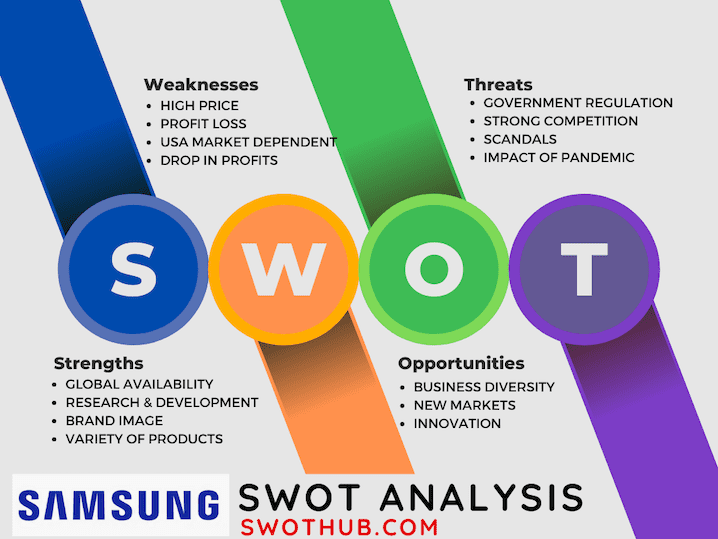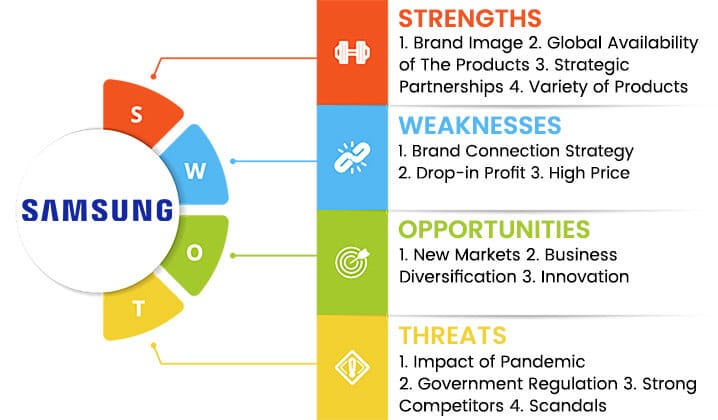Determining how to perform a competitive SWOT analysis is the identification and evaluation of a company’s strengths, weaknesses, opportunities, and threats. A SWOT meaning determines two internal factors for example: determining the strengths and weaknesses, and two external factors i.e. opportunities and threats. The parts of a SWOT analysis provide the project manager with planning out the project while considering the factors that will be helpful or hindering the success of that project. A project manager identifies controllable factors and risks using SWOT analysis and eventually pays attention to and monitors the project’s progress. A good SWOT analysis example is this Samsung company overview.

How to find a Competitive SWOT Analysis
You can start writing a SWOT analysis paper by identifying your goals and objectives. The next step is to research your company, market, and overall industry you are doing business. You will gather data about your employees, competitors, customers, and partners and analyze it. Now, you will use a SWOT analysis matrix that lists down all the key areas to be evaluated in the process. Once you list down all the questions in each respective factor, you will formulate a strategy addressing all the problems identified in the process.
How to find a Competitive SWOT analysis for your Organization
What are the four parts of a SWOT Analysis?
You can also call these four main parts of SWOT analysis. These factors guide you to develop areas where you are doing well, acknowledge what you are lacking, minimize the risks and grab new openings. Let’s explain the four elements of SWOT analysis.

1. Determine the SWOT Analysis strengths
In a competitive SWOT analysis finding the strengths mean how well your organization is working, or the areas in which you outperform your competitors. Your strengths could be your special expertise, rich knowledge, cost advantages, better reputation, technology advantages, strong relationships, and better history.
You can make your organization strong by responding quickly to market changes, developing a flat hierarchy for quicker decision-making, and lowering overhead costs. These factors are always a source for you to get and maintain a competitive edge over your competitors.
2. Find the Company’s Weaknesses
Weaknesses mean what your business lacks or needs improvements in as compared to your competitors. Here, you look into how your competitors are performing better than you. You might have limited products or services, marketing problems, staffing problems, low brand power, and marketing deficiencies as your weaknesses.
When your organization’s existing workload is too high, you have no or low project planning experience, and you are missing expertise in major areas, your organization is weak. Factors like these can put you behind your competitors so you should work on them at the earliest.
3. Identify the opportunities in the SWOT analysis
You name opportunities as chances of some positive openings to happen, that you will claim yourself. They occur outside the environment of the organization, and it is your responsibility to put light on what will happen in the future. The presence of new technology, new markets, new customers, better-trained staff, new products or services, and lack of competition might be counted as your opportunities.
Whenever you find opportunities like increasing market share, cutting down costs, and grabbing new markets, you must go for them. You should never miss these opportunities to outperform your competitors.
4. Find the threats the company has from outside forces
Anything from the external environment that can put a negative effect on your business comes under threats. It is essential to predict threatening factors and take action against them before they have control over you. Your threats might be factors such as increased or new competition, demographic changes, economic crises, and governmental policies.
When your business partners have little loyalty towards you, your competitors get more market share than you, or the cost of switching technology is much higher, you are prone to threats. You always need to be aware of the threats in the environment and control them before they control your business.
How is SWOT analysis used for competitive advantage?
Now, you might be thinking about how to find a SWOT analysis of a company. Knowing about the four parts of SWOT analysis is mandatory but not enough until you understand how to write a SWOT analysis paper and what is the importance of using a first-rate SWOT analysis for a competitive advantage. Both of these components complement the effectiveness of conducting a SWOT analysis.
By using a first-rate SWOT analysis, you can get the basis to craft a business strategy that will capitalize on the company’s strengths, capture the best opportunities for the company, and provide well-being to the company by defending it against all threats. In short, it will give the maximum productive results to improve your business for which you conducted the SWOT analysis.
What if we tell you that there is a tool that puts you in your competition’s frame of mind called competitor SWOT analysis? It includes looking into all four determinants of SWOT analysis for your competitor’s business. It is key to know where your competitors lie in terms of your position.
When you carefully look into the SWOT factors of your competitor and gather data, it is time to analyze each factor separately. After careful analysis of each factor using multiple tools, you decide whether to eliminate or adopt a new action plan, make changes in the existing models, and grab a new opportunity to help you gain a competitive edge. The last step is to take the action.
Is a SWOT analysis outdated?
Many people still have a question in their mind: “Are SWOT analyses still used?” Philip Twyford, Digital Specialist says even though SWOT analysis has been used as a tool since early marketing history, its use is still valuable today. No matter if your business is in its planning stage or on various growth points, SWOT analysis helps it follow the proposed path.
Every tool has its pros and cons. If you do not find SWOT analysis effective enough, you can opt for its alternatives. No matter which model you implement, you will face certain cons and limitations in each as compared to others. The best way is to integrate two or more tools to get the maximum results desired to meet your business goals.
SWOT Analysis Examples
If you’re looking for industry competitive SWOT ideas try these, or choose from the below:
Tourism SWOT Analysis

Restaurant Industry SWOT Analysis

Textile Industry SWOT Analysis

If you’re looking for examples of SWOT analyses take a look at the categories on SWOT Hub.
